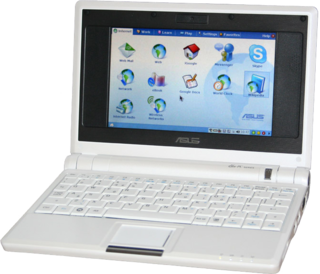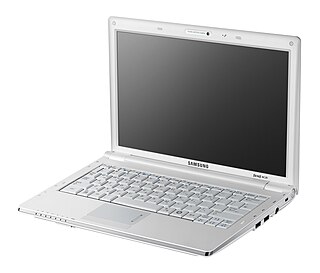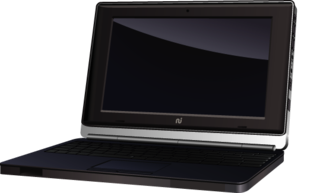
A laptop computer or notebook computer, also known as a laptop or notebook for short, is a small, portable personal computer (PC). Laptops typically have a clamshell form factor with a flat panel screen on the inside of the upper lid and an alphanumeric keyboard and pointing device on the inside of the lower lid, although 2-in-1 PCs with a detachable keyboard are often marketed as laptops or as having a "laptop mode". Most of the computer's internal hardware is fitted inside the lower lid enclosure under the keyboard, although many laptops have a built-in webcam at the top of the screen and some modern ones even feature a touch-screen display. In most cases, unlike tablet computers which run on mobile operating systems, laptops tend to run on desktop operating systems which have been traditionally associated with desktop computers.
Casio Cassiopeia was the brand name of a PDA manufactured by Casio. It used Windows CE as the Operating system. Casio was one of the first manufacturers of PDAs, developing at the beginning small pocket-sized computers with keyboards and grayscale displays and subsequently moving to smaller units in response to customer demand.
The Classmate PC, formerly known as Eduwise, is Intel's entry into the market for low-cost personal computers for children in the developing world. It is in some respects similar to the One Laptop Per Child (OLPC) trade association's Children's Machine (XO), which has a similar target market. Although made for profit, the Classmate PC is considered an Information and Communication Technologies for Development project (ICT4D). Introduced in 2006, the device falls into the then popular category of netbooks.

Asus Eee is a family of products by AsusTek Computer Inc. The product family began with the release of the Eee PC subnotebook in 2007; since then, the product family has diversified into a number of PC form factors. According to the company, the name Eee derives from "the three Es," an abbreviation of its advertising slogan for the device: "Easy to learn, Easy to work, Easy to play".

The ASUS Eee PC was a netbook computer line from Asus, and a part of the ASUS Eee product family. At the time of its introduction in late 2007, it was noted for its combination of a lightweight, Linux-based operating system, solid-state drive (SSD), and relatively low cost. Newer models added the options of Microsoft Windows operating system and rotating media hard disk drives (HDD), and initially retailed for up to 500 euros.

The OLPC XO is a low cost laptop computer intended to be distributed to children in developing countries around the world, to provide them with access to knowledge, and opportunities to "explore, experiment and express themselves". The XO was developed by Nicholas Negroponte, a co-founder of MIT's Media Lab, and designed by Yves Behar's Fuseproject company. The laptop is manufactured by Quanta Computer and developed by One Laptop per Child (OLPC), a non-profit 501(c)(3) organization.
The Elonex ONE was a netbook computer marketed to the education sector by Elonex. The ONE's operating system was called Linos, based on Linux kernel 2.6.21, and the device had Wi-Fi connectivity, Ethernet networking, a solid-state hard drive, two USB ports and weighed less than 1 kg.
These tables provide a comparison of netbooks.

The Gdium is a subnotebook / netbook computer produced by EMTEC. The Gdium product is distinguished by its unique Loongson MIPS processor and the use of a USB key as a primary storage device. The Gdium netbook is marketed as an interface device to the Gdium "learning community"—a website that provides hardware support, MIPS builds of open-source software, Linux computing tips, and educational resources targeted towards teachers and students within the K-12 demographic.
The Dell Inspiron Mini Series is a line of subnotebook/netbook computers designed by Dell. The series was introduced in September 2008 amidst the growing popularity of low-cost netbook computers introduced by competitors.
Digital newspaper technology is the technology used to create or distribute a digital newspaper.

The Samsung NC20 is a subnotebook / Netbook computer designed by Samsung. At the time of its introduction,, it was the first mainstream netbook to use the VIA Nano processor and the first to support the x86-64 instruction set. The 12.1" screen size is larger than typical for this class of ultra portable PC. Its most direct competitors are the Lenovo IdeaPad S12 and the MSI Wind U210.
The Apricot Picobook Pro is the first product of the reformed Apricot Computers. It is a netbook based on the VIA NanoBook, first shown to the press on October 15 2008.
The Asus Eee T91 is a touchscreen netbook from the Asus Eee PC range. It is similar in specification to other netbooks, but features an 8.9" rotatable touchscreen and a retractable stylus.

HP Mini is a former line of small computers categorized as netbooks manufactured by Hewlett-Packard. They either contained a custom version of Ubuntu Linux, Microsoft Windows XP Home Edition or Windows 7 Starter operating system. Like most netbooks, they were not built with CD/DVD drives. They were announced from mid-2007, and marketed from 2008 through 2012.

The Touch Book is a portable computing device that functions as a netbook, and a tablet computer. Designed by Always Innovating, a company situated in the city of Menlo Park, in California, USA, it was launched at the DEMO conference in March 2009. Its designers stated at launch that it is the first netbook featuring a detachable keyboard with a long battery life. It is based on the ARM TI OMAP3530 processor and features a touchscreen.

The IdeaPad S Series is a series of notebook computers launched by Lenovo in October 2008. The IdeaPad S10 was initially scheduled for launch in September, but its release was delayed in the United States until October.
The Lenovo Miix was a series of multi-mode computing devices that function as both a tablet and a notebook computer.

The Surface Hub is a brand of interactive whiteboard developed and marketed by Microsoft, as part of the Microsoft Surface family. The Surface Hub is a wall-mounted or roller-stand-mounted device with either a 55-inch (140 cm) 1080p or an 84-inch (210 cm) 4K 120 Hz touchscreen with multi-touch and multi-pen capabilities, running the Windows 10 operating system. The devices are targeted for businesses to use while collaborating and videoconferencing.

The Surface Studio is an all-in-one PC, designed and produced by Microsoft as part of its Surface series of Windows-based personal computing devices. It was announced at the Windows 10 Devices Event on October 26, 2016, with pre-orders beginning that day.













